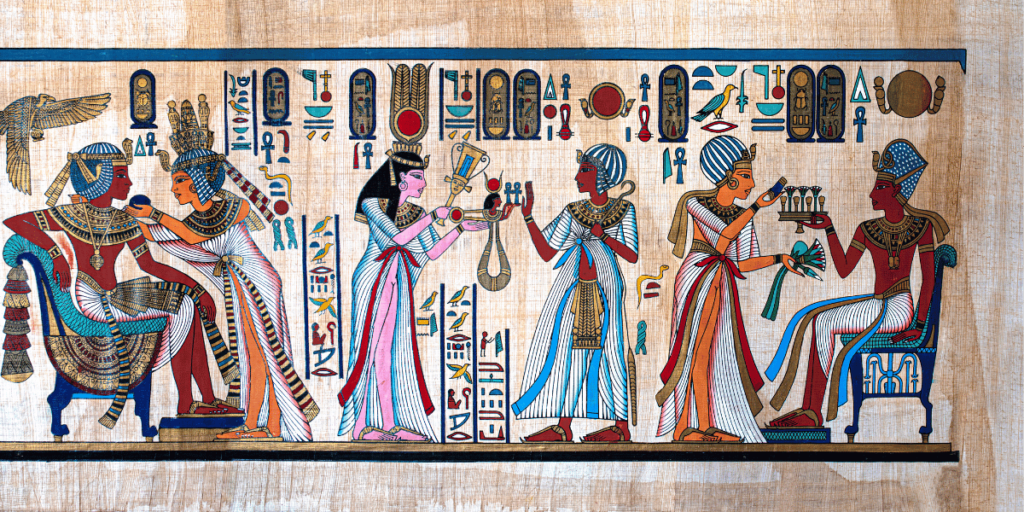Art is a time capsule of human expression, a visual dialogue that transcends centuries. Imagine stepping back in time to witness the vibrant colors of ancient Egyptian murals, the exquisite forms of Greek sculptures, and the intricate designs of ancient Chinese pottery—each piece telling stories woven into the very fabric of civilization. In this blog post, we embark on an enlightening journey through three pivotal cultures that shaped our artistic heritage: Egypt’s enigmatic pharaohs and their monumental creations; Greece’s pursuit of beauty through philosophy embodied in art; and China’s harmonious blend of nature and spirituality reflected in its masterpieces. Join us as we unravel the threads connecting these diverse traditions and discover how they continue to influence contemporary creativity today!
Introduction to Ancient Art
Ancient art is a captivating window into the past. It whispers stories of civilizations long gone, revealing their beliefs, values, and daily lives through remarkable creations. From the grand pyramids of Egypt to the intricate sculptures of Greece and the delicate brush strokes of China, each culture has left an indelible mark on history.
As we delve into this rich tapestry of ancient artz, we’ll uncover its significance and explore how these masterpieces continue to inspire us today. Join us on this journey as we examine key characteristics and notable artworks from three influential civilizations: Egypt, Greece, and China. Let’s embark on a fascinating exploration that highlights not just artistic techniques but also profound themes that resonate across time!
Definition of Ancient Art And Its Significance
Ancient art refers to creative expressions from early civilizations dating back thousands of years. This includes sculpture painting pottery architecture among others.
The importance lies in ancient works as storytelling tools. Each artifact reveals thoughts about what people believed about god, life and other cultures. This is an opportunity for us to understand social structures, cultural practices as well as any kind of a civilization belonging to that period.
Additionally, ancient artwork acts as the bridge between us and our ancestors who’s thoughts and feelings are passed down from one generation to another. They are an enduring legacy left behind by these people beyond time.
Moreover, in studying these artworks we find out about mutual human lives that bring different civilizations in the world together. Ancient art explores not just visual beauty but also historical stories waiting to be discovered.
The Development of Ancient Art In Egypt Greece And China
Ancient art flourished uniquely across Egypt, Greece, and China each civilization expressed its culture through distinct styles and techniques.
In Egypt art was divine. Sarcophagi were covered with hieroglyphics while figures of pharaohs were carved out portraying them in idealized forms. It was this approach to immortality that determined their artistic pursuit.
Greece brought realism into ancient art. The Greeks venerated human beauty and physical fitness. On their pottery were engraved scenes from myths whereas statues like Venus de Milo had details so intricate they seem almost alive.
Chinese artistry intertwined deeply with philosophy and nature. Alongside ink paintings featuring serene landscapes or delicate flowers calligraphy became an integral part of Chinese worshiping ceremonies among other things conveying harmony between humankind and nature in general.
Their works reflect the values expressed by each civilization’s artifacts in terms of what they believed personally or culturally which continue inspiring artists till date showing how ancient cultures have impacted on modern creativity.
Key Features and Styles of Each Civilization
Ancient Egyptian art, also known as the Amarna Period, was based on a strict adherence to tradition. It was distinguished by hieroglyphs, elaborate tomb paintings and monumental architectural structures such as pyramids that reflect spiritualism and notions of the afterlife. Some colors were symbolic; for example green could mean fertility just like red stood for chaos.
In Greece, it led to the use of humanism in artwork. This led to an idealized representation in their sculptures—for instance, think about Doryphoros by Polykleitos which is a representation of a perfect athlete. Pottery was another area where great strides were made with mythological scenes being painted on them depicting real life situations.
The ancient art of China exhibited harmony with nature and philosophical ideals. Calligraphy became both a form of art and religious practice. Landscape paintings often showed vast mountains or still waters indicating simple but deep emotions.
Each civilization adopted different themes—spiritualism for Egypt, humanism for Greece, and equilibrium for China—all adding valuable insights into our understanding ancient arts today.
Examples of Notable Artworks from Each Civilization
An awe-inspiring piece from Ancient Egypt is “Mask of Tutankhamun.” The golden mask enveloped lapis lazuli and turquoise which symbolizes not only wealth but also the luxuriousness characteristic of burials conducted on young pharaohs. The complexity conveys divine protection as well as immortality.
The famous “Venus de Milo” is one artwork that represents beauty through elegance in Greece. Believed to be from 150 – 125 BC, this breathtaking statue is Aphrodite’s made up ideal human proportions coupled with an artistic design that has influenced generations upon generations.
With respect to ancient China, this section will discuss the Terracotta Army that is perhaps one out many remarkable objects exemplifying Emperor Qin Shi Huang’s pursuit for eternal life. Discovered in 1974, this life-size terracotta soldiers were made as sentinels for his tomb they stand as an eternal guard of honor, and are a testimony to the high crafting techniques and military history.
Every work of art speaks volumes about their respective cultures while also helping us to better understand ancient civilizations. The richness of the contexts is pure enthralling.
Comparing and Contrasting the Three Civilizations’ Artistic Techniques and Themes
Ancient Egyptian, Greek, and Chinese art all have individual but intertwined cultural stories. Egyptian art was always formalistic with lots of symbolism. Hieroglyphs usually accompanied vivid images of gods or pharaohs where every detail had been carefully designed in view of eternity.
Conversely, Greeks loved humanism. One could see intricate details on Classical sculptures that looked real due to proportional representation. Moving subjects were more popular than static objects which defined ancient Egypt’s works.
Artistry in China thrives on ingenuity. Brush painting is an example technique which stresses on naturalness rather than imitation when dealing with nature. Calligraphy is not merely a writing; it is a way that artists can express their philosophy through illustration.
These civilizations share themes of spirituality and society but differ in execution—Egypt’s permanence versus Greece’s dynamism against China’s introspective elegance creates a rich tapestry worth exploring further.
Similarities and Differences
Culture came out differently in each civilization through distinct styles and themes in their arts.
Symbolism was central to artistic practice during the Amarna Period or Ancient Egypt when it came to art. Artists focused on religious beliefs, depicting gods and the afterlife in vibrant colors.
But Greek art pursued humanism instead. Sculptors used realism in making their human forms beautiful by staying true to proportionality laws while capturing movement often denoting athletic feats.
Chinese ancient art paid special attention to harmony with nature mainly through landscape paintings that depicted balances and ceramics with intricate designs that tell stories of the people.
However, all cultures had a common thread: they employed art as a means of communication. For instance, these societies used visual language to describe the stories that were associated with their people’s values and aspirations. Thus, ancient art has been made more meaningful by this combination of individual expression in relation to the wider framework.
The Impact of Ancient Art on the Modern World
Modern society is still influenced by ancient art which takes various forms such as popular culture. This includes fashion and fine arts, among others.
For example, sculpture. Contemporary sculptors are inspired by techniques that were used by ancient craftsmen. The materials and approaches have changed but essentially remained rooted in history.
On many occasions, fashion designers imitate patterns from Egyptian hieroglyphics or Greek pottery. These designs make it look like we are in a time loop because they never get old.
Many museums across the globe display these treasures thus enlightening visitors about their relevance today. By understanding this aspect, one can easily relate to past societies and modern life.
In addition, Doric and Ionic columns are commonly found in contemporary structures. Through this way of designing buildings seem imposing yet classic forms of art are recognized.
This preservation effort shows our desire to keep alive the rich tapestry of ancient art amidst our current fast-paced existence so it will be there for the future generations to enjoy.”
Influence on Contemporary Art, Design and Fashion
Various fields continue to draw inspiration from ancient works of art. This is manifested through themes, techniques as well as aesthetics that resonate with today’s artists’ minds like those who practice design or even come up with fashionable apparel.
In fine arts sector for instance you will find elements derived from Egyptian hieroglyphs or Greek pottery being incorporated into modern day paintings and installations; most times these influences bring about historical perspectives but give new ways for seeing things differently.
Fashion designers usually adopt styles from earlier periods. Draping fabrics such as those resembling the Roman togas and intricate patterns inspired by Chinese silk weaving can be witnessed on all reputable runways around the world.
Also, ancient architectural ideas are evident in various contemporary designs. The Greek and Roman classical buildings show an equilibrium which is repeated in buildings using symmetry.
Even graphic designers use such themes as color pallets or patters from prehistoric art. In such manner he creates not only a “bridge” between past and present but also makes it audience across the globe.
Preservation and Conservation Efforts
Restoring ancient art helps us understand our history better. Fragments of old cultures keep stories connected to the past.
Conservation strategies often require detailed approaches that analyze the materials, techniques, etc., used by ancient artists. It is this knowledge that will inform how these delicate works can be restored without losing their essence.
Such initiatives are supported worldwide by many institutions ranging from museums to cultural organizations. Exactly, it will help pass on essential skills for conserving fragile objects to future generations through collaboration between museums, universities, and cultural organizations.
Public awareness campaigns also play a very important role here. Outreach programs are aimed at educating communities about importance of preserving heritage sites and pieces of artwork in them thus providing them with additional reasons to hold onto their cultural heritage.
These combined efforts ensure that posterity would enjoy ancient art’s beauty while deepening our shared human experience as we celebrate diverse histories across continents.
Prehistoric vs Pre-Columbian Art: What Sets Them Apart?
Works created during prehistory are referred to as prehistoric art; they include carvings inside caves or sculptures made by early men depicting either animals or people in simple forms. These were likely done for religious or ritualistic purposes as food was scarce then.”
The Americas had Pre-Columbian art prior to European contact. They are a diverse group of cultures such as Inca and Aztec. This makes the works more complex, with detailed designs and symbols that mirror their advanced societies.
Unlike prehistoric art which is about basic representation, Pre-Columbian works delve into sophisticated techniques such as pottery and metalwork. Though both have unique styles that narrate events in their respective culture’s history, they were produced in different temporal contexts—one dealing with earliest expressions of humanity and the other revealing great civilizations at their peak.
Explanation of Distinct Categories
Prehistoric art refers to ancient man’s creative expression. That includes cave paintings, carvings and sculptures done thousands of years ago. The animals and human figures found in these pieces represent the day-to-day life as well as beliefs of olden communities.
On the other hand, Pre-Columbian art covers a wide range of artistic traditions from the Americas before European contact. These include the Mayan civilization, Aztecs and Incas among others. Their work involves intricate pottery, textiles, and monumental architecture full of symbolism.
These categories indicate different cultural values or practices. While prehistoric artists used natural materials for crafting purposes, those who made Pre-Columbian objects displayed advanced technical skills with metals and ceramics in particular. By use of visual storytelling these two categories serve an important role in understanding how mankind has evolved over time period.Unlocking new ways through which we can capture our past using visual language.
Examples of Notable Works in Each Category
For example, Ancient Egypt is known for its majestic pyramids and detailed tomb paintings; one stand out piece being “Mask of Tutankhamun.” In this golden burial mask lies all elements that constitute pharaonic art representing exceptional expertise put together by artisans.
In Greece classicism is represented by Parthenon frieze while it depicts a grand procession honoring Athena done in a stunning detail and harmony of forms that are typical for ancient Greek aesthetics.
Terracotta Army in China is an impressive evidence of the power of emperors. These life-sized figures which were discovered in Xi’an were buried with Emperor Qin Shi Huang to guard him during his journey after death.
Every artwork portrays its culture’s values and beliefs. They, therefore, show us their own stories but also give us some ideas about our shared past through this ancient art gallery.
Conclusion: Appreciating the Rich Tapestry
The examination of ancient art reveals a vibrant tapestry woven through the ages. Egypt, Greece, and China—each has added its own unique thread to this intricate design. Their respective works’ different styles and techniques reflect both cultural beliefs as well as social dynamics within those times.
Ancient Egyptian art is characterized by strong symbolism that reinforces tradition showing gods’ connection with pharaohs. In Greek art humanism was celebrated with any beauty depicted through proportionate forms that expressed emotions and movements. Conversely, Chinese art stresses on balance with nature hence making use of bold brushwork or portraying deep philosophical meanings beneath it all.
Although they differ considerably, these civilizations have similarities in depicting spiritual convictions artistically while addressing themes like love, life, death and power on a universal level. This common narrative highlights how interconnected humanity has always been across time periods.
Today’s modern culture still draws heavily from ancient art. Artists continue to reference these timeless works; designs incorporate classical motifs into contemporary wear; architects integrate age-old features with cutting-edge planning systems. The preservation efforts ensure that future generations continue appreciating such masterpieces amidst endless changes happening worldwide.
Our understanding of ancient creativity will be enhanced with the knowledge of the differences between prehistoric and pre-Columbian arts. From the material used to thematic contents, they are always different and thereby we get a lot of insights into various human experiences across history.
In conclusion, exploring the vast heritage of ancient art helps us stay in touch with our past and guide our artistic activities in current situations. Moreover, this inheritance revolves around allowing us to engage deeply over identity and expression throughout diverse cultures as each painting carries a story that is worth saving.






